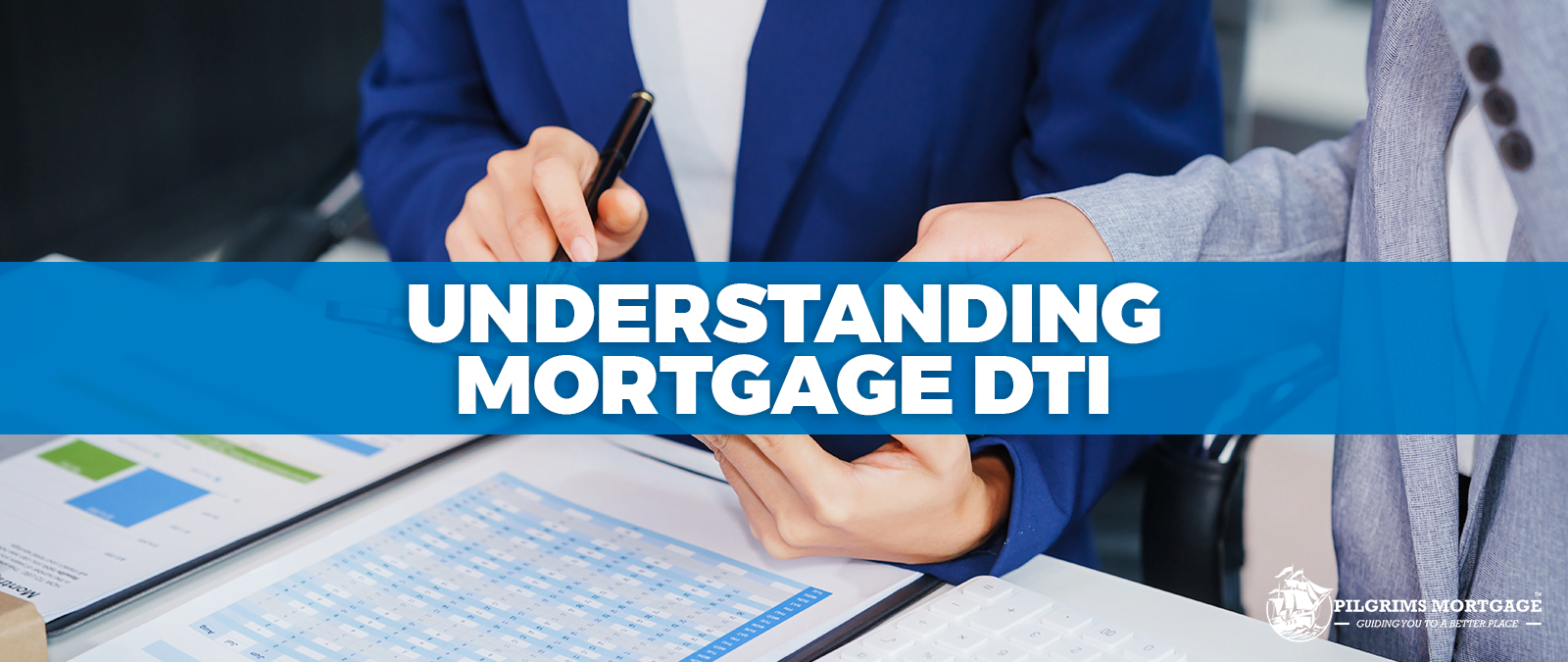In this article, we’ll delve into how mortgage DTI is calculated, its significance, and what it means for your homebuying journey. When applying for a mortgage, lenders consider several factors to determine your creditworthiness and ability to repay the loan. One crucial aspect is your debt-to-income (DTI) ratio, which measures your monthly debt payments against your gross income. What is Mortgage DTI? Mortgage DTI is the percentage of your monthly gross income that goes towards paying debts, including the proposed mortgage payment, other loans, credit cards, and minimum payments on revolving debts. Lenders use this ratio to assess your ability to manage your debt burden and ensure you’re not overextending yourself. How is Mortgage DTI Calculated? To calculate your mortgage DTI, lenders follow these steps: For example: Gross income: $5,000 per month Total monthly debt payments: $2,500 DTI calculation: ($2,500 ÷ $5,000) x 100 = 50% In this scenario, your mortgage DTI is 50%, indicating that half of your gross income goes towards debt repayment. Why Does Mortgage DTI Matter? Lenders consider DTI a critical factor in mortgage approval because it reveals your ability to manage debt and make timely payments. A high DTI ratio may indicate overextension, increasing the risk of default. Generally, lenders prefer a DTI ratio of 45% or less, although some may accept higher ratios depending on compensating factors like a high credit score or substantial assets. Tips to Improve Your Mortgage DTI If your DTI ratio is higher than desired, consider these strategies: Conclusion Understanding mortgage DTI is essential for homebuyers and homeowners alike. By grasping how lenders calculate this ratio and maintaining a healthy DTI, you’ll improve your chances of securing a favorable mortgage deal and ensuring a sustainable financial future. Remember, a lower DTI ratio can lead to better loan terms, lower interest rates, and a more secure financial footing.
Securing a mortgage can be a daunting task for anyone, but self-employed borrowers often face unique challenges that make the process even more complex. One of the primary hurdles is proving consistent income. Unlike salaried employees who can present regular pay stubs and a steady employment history, self-employed individuals may have fluctuating income streams. This variability can raise red flags for lenders who seek stability and predictability in a borrower’s financial profile. Another significant challenge lies in the limitations of traditional tax returns. Self-employed individuals often take advantage of various deductions to reduce their taxable income. While this is beneficial for tax purposes, it can be detrimental when applying for a mortgage, as it may appear that the borrower earns less than they actually do. Lenders typically scrutinize tax returns from the past two years to assess income, and substantial deductions can complicate this evaluation, making it difficult for self-employed borrowers to demonstrate their true earning potential. Moreover, there is often a general skepticism among lenders towards self-employment income. Lenders may perceive self-employment as inherently riskier compared to traditional employment due to the lack of guaranteed income and the potential for business downturns. This skepticism can result in more stringent qualification criteria, higher interest rates, or even outright denial of mortgage applications for self-employed individuals. These challenges underscore the importance of exploring alternative qualification methods for self-employed borrowers. By understanding the unique financial landscape of self-employment and utilizing innovative approaches, it is possible to navigate the mortgage qualification process more effectively. This blog post will delve into various alternative pathways that can help self-employed individuals secure a mortgage, providing them with the necessary tools to overcome these common obstacles. Alternative Income Verification Methods For self-employed borrowers, qualifying for a mortgage can often be challenging due to the variability of their income. Traditional income verification methods, such as tax returns, may not accurately reflect the financial health of an individual whose earnings fluctuate. Fortunately, lenders offer alternative methods to verify income, providing more flexibility for self-employed individuals. One common alternative is the use of bank statements. Lenders review a specified period, typically 12 to 24 months, of personal and business bank statements to assess consistent cash flow. This method allows borrowers to demonstrate their ability to generate income. The primary advantage is that it provides a clearer picture of ongoing financial stability, particularly for those whose tax returns do not exhibit their true earning potential. However, this method can be time-consuming and may require extensive documentation, which can be a drawback for some borrowers. Another method is asset depletion. This approach involves converting an individual’s liquid assets into a hypothetical income stream. The lender calculates a monthly income by dividing the total value of the assets by a certain number of months. This method is particularly beneficial for individuals with significant savings or investments but lower reported income. The main benefit is that it allows borrowers to leverage their assets effectively. However, it may not be suitable for those with limited liquid assets or those who prefer to keep their investments intact. Other innovative methods include profit and loss statements and accountant’s letters. Profit and loss statements, prepared by a certified accountant, provide a detailed breakdown of a business’s income and expenses. An accountant’s letter can also serve as a verification tool, offering professional assurance of a borrower’s financial stability. While these methods offer a more tailored approach, they may require professional assistance and incur additional costs. Overall, these alternative income verification methods offer self-employed borrowers a range of options to demonstrate their financial capability. Each method has its pros and cons, and the best choice will depend on the individual’s unique financial situation and the lender’s requirements. Understanding these alternatives can significantly enhance the chances of securing a mortgage for self-employed individuals. Non-Traditional Loan Options for Self-Employed Borrowers Self-employed borrowers often encounter challenges when seeking traditional mortgage loans due to the unpredictable nature of their income streams. Fortunately, various non-traditional loan options are available that cater specifically to their unique financial circumstances. These alternatives include stated income loans, asset-based loans, bank statement loans, private money loans, and non-qualified mortgage (non-QM) loans. Stated income loans are designed for borrowers who may not have the standard proof of income typically required by conventional lenders. Instead of traditional income documentation, borrowers can state their income on the loan application. These loans offer greater flexibility but often come with higher interest rates and require a significant down payment to mitigate the lender’s risk. Asset-based loans are another viable option for self-employed individuals. These loans rely on the borrower’s assets—such as investment portfolios, real estate, or cash reserves—rather than income documentation. The value of these assets provides the foundation for the loan approval process. However, potential drawbacks include higher interest rates and the risk of asset liquidation if the borrower defaults. Bank statement loans allow borrowers to qualify for a mortgage based on the deposits reflected in their bank statements over a specified period, typically 12 to 24 months. This approach is advantageous for self-employed borrowers who may have irregular income but maintain strong cash flow. While bank statement loans offer flexibility, they often come with stringent eligibility criteria and higher interest rates. Private money loans, also known as hard money loans, are short-term financing options typically provided by private investors or companies. These loans prioritize the value of the property over the borrower’s creditworthiness or income history. Private money loans can be beneficial for borrowers needing quick financing, but they usually have higher interest rates and shorter repayment terms. Non-qualified mortgage (non-QM) loans are tailored for borrowers who do not meet the strict guidelines of conventional mortgages. These loans provide flexibility in income verification and credit standards, making them suitable for self-employed borrowers. While non-QM loans are accessible, they often come with higher interest rates and may require a larger down payment. In conclusion, self-employed borrowers have access to several non-traditional loan options, each with its own set of features, benefits, and potential
Jumbo loans are a type of non-conforming mortgage that exceeds the conforming loan limits set by Fannie Mae and Freddie Mac, the two government-sponsored enterprises that purchase and securitize mortgages. In most areas of the United States, the conforming loan limit is $510,400, although it can be higher in certain high-cost areas. Jumbo loans are designed for borrowers who need to finance a larger amount than the conforming loan limit, often to purchase a more expensive home or refinance an existing mortgage. These loans are considered non-conforming because they do not meet the underwriting guidelines of Fannie Mae and Freddie Mac, and therefore cannot be sold to these entities. Characteristics of a Jumbo Loan Jumbo loans have several distinct characteristics that set them apart from conforming loans: Types of Jumbo Loans There are several types of jumbo loans available, including: Benefits of Jumbo Loans A Jumbo loan offers several benefits for borrowers who need to finance a larger amount: Conclusion A Jumbo loan is a financing option for borrowers who need to finance a larger amount than the conforming loan limit. While they may have stricter credit requirements and higher interest rates, jumbo loans offer flexibility and competitive terms for borrowers who need to finance more expensive homes or refinance existing mortgages with higher balances. By understanding the characteristics and benefits of a jumbo loan, borrowers can make informed decisions about their mortgage options.



